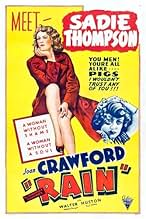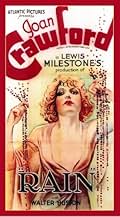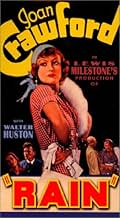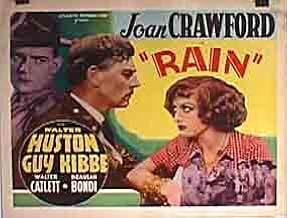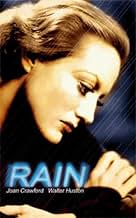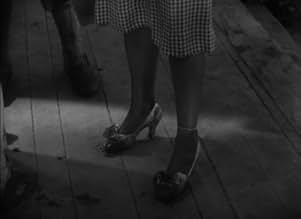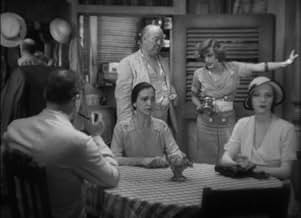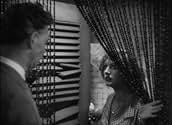CALIFICACIÓN DE IMDb
6.9/10
3.3 k
TU CALIFICACIÓN
Una prostituta recién llegada al Pacífico Sur se enfrenta a un severo misionero decidido a salvar su alma.Una prostituta recién llegada al Pacífico Sur se enfrenta a un severo misionero decidido a salvar su alma.Una prostituta recién llegada al Pacífico Sur se enfrenta a un severo misionero decidido a salvar su alma.
- Dirección
- Guionistas
- Elenco
- Premios
- 3 premios ganados en total
Fred Howard
- Hodgson
- (as Frederic Howard)
Ben Hendricks Jr.
- Griggs
- (as Ben Hendricks)
Opiniones destacadas
RAIN (United Artists, 1932), directed by Lewis Milestone, from the short story about sex, sin and salvation by W. Somerset Maugham, stars Miss Joan Crawford (courtesy of the Metro-Goldwyn-Mayer Company), in one of her most prestigious movie roles that stands in a class by itself. Originating as a 1922 stage play starring Broadway's legendary Jeanne Eagles, it first appeared on screen during the silent era as SADIE THOMPSON (United Artists, 1928), starring Gloria Swanson and Lionel Barrymore. Regardless of its then controversial subject matter, it did well at the box office, earning Swanson an Academy Award nomination. Four years later, it was remade as RAIN. Considering what might have been logical choice in having Swanson and Barrymore reprising their original roles with spoken dialog in place of title cards, Crawford and Walter Huston, forceful screen personalities, were fine substitutes. Unfortunately, lightning or heavy rains didn't strike twice, for that Crawford's sound adaptation reportedly became a box-office flop. The fault might have been for its bad timing, remaking a film so close to its original, and Jeanne Eagles still being in the memory of those who have witnessed her performance on stage, yet had RAIN been distributed a few years later, it might have met with problems with the censors and production code, thus, not having that spark of solid dialog that this version has, and yet, probably would not have had that "filmed stage play" appearance either. The camera does take time out for some location viewing of the Cataline Islands, where portions of the film were reportedly lensed.
For the benefit of those who are totally unfamiliar with the Maugham story and/or the movie itself, the plot is set in Pago Pago, the Samoan island where a group of steamer passengers are forced to remain because of a minor epidemic on board. And due to the heavy rains, they find they must stay a little longer than anticipated. Among the passengers entering the island's general store/hotel run by Joe Horn (Guy Kibbee) and his native wife (Mary Shaw) are Doctor Robert MacPhail (Matt Moore), a philosopher, and wife, Nina (Kendall Lee); Alfred and Martha Davidson (Walter Huston and Beulah Bondi), a missionary couple, among others. Entertaining the Marines in her state room is Miss Sadie Thompson (Joan Crawford), a prostitute, who enjoys the company of men, playing loud jazzy music and cigarette smoking. She quickly catches the eye of Sergeant Tim O'Hara (William Gargan) but the disapproval of Davidson, who objects to her immoral ways such as drinking and smoking on the Sabbath. At first Davidson forces himself upon her to reform. All he finds is that his religious persistence annoys her and that Sadie can be equally demanding and powerful as he. Sadie tries to meet him half way when she learns that she must return to San Francisco and serve a three year prison sentence, and becomes bitter when Davidson won't give in to her pleas. Eventually Davidson does succeed in saving Sadie's immortal soul by cleansing her from her sins, but in turn, Davidson soon finds himself being lead into temptation and unable to be delivered from evil.
For many years, RAIN has earned the reputation as being one of Crawford's mistakes. On the contrary, it's Crawford's performance that keeps the story together. For the first hour, she appears with cat eyes, heavy makeup, curly hair, cigarette, birth mark under the left side of her chin and wearing a tight checkered dress. Her transformation scene occurring later having Crawford's Sadie cleansed from her sins and appearing pure at heart, is surprisingly effective. Walter Huston almost upstages Crawford every which way he can. He, too, gives a solid performance as the Reverend Davidson. The famous scene where Davidson recites the Lord's prayer with the swearing Sadie suddenly reciting the prayer with him, is one of the film's true memorable moments. This scene itself became a clip used for the mid 1970s TV show, "Don Adams Screen Test," for young hopefuls to re-enact this particular scene and win a trip to Hollywood and a part in an upcoming TV show or motion picture. Up to then, RAIN was winning a new audience.
Director Milestone was given a difficult task in keeping the pace moving by circling the camera around, moving it at all different angles so not to focus on the central characters for any length of time. His directing technique might not meet with much appreciation today, but his overlooked method as to how to develop the story and characters on a set stage are evident here. Along with forceful dialog, Milestone full takes advantage of this new medium of sound with the use of repeated rain heard falling on the ground and rooftops. The Alfred Newman underscoring benefits the film as well.
I first came across RAIN when it made a special television presentation on WNEW, Channel 5, in New York City, June 10, 1973. Preceding the movie was a surprise presentation by Joan Crawford herself giving her profile about working in RAIN. Initially released at 93 minutes, a 77 minute print was presented during its 90 minute time slot with commercial interruptions. By the 1980s, however, RAIN became one of many public domain titles distributed to home video, mostly in full length. Cable television presentations shortly afterwards, ranging from Arts and Entertainment and the Learning Channel (1980s), American Movie Classics (1991-2000) and Turner Classic Movies (TCM premiere March 8, 2007).
Columbia updated the Maugham story to post World War I as MISS SADIE THOMPSON (1953) starring Rita Hayworth and Jose Ferrer, with the addition of Technicolor and songs. Of the three screen incarnations of Sadie Thompson vs. The Reverend Davidson (The Prostitute and the Reformer), RAIN (1932) is the best known and revived, especially on rainy day. Although the film itself has aged, the story itself hasn't. (**1/2)
For the benefit of those who are totally unfamiliar with the Maugham story and/or the movie itself, the plot is set in Pago Pago, the Samoan island where a group of steamer passengers are forced to remain because of a minor epidemic on board. And due to the heavy rains, they find they must stay a little longer than anticipated. Among the passengers entering the island's general store/hotel run by Joe Horn (Guy Kibbee) and his native wife (Mary Shaw) are Doctor Robert MacPhail (Matt Moore), a philosopher, and wife, Nina (Kendall Lee); Alfred and Martha Davidson (Walter Huston and Beulah Bondi), a missionary couple, among others. Entertaining the Marines in her state room is Miss Sadie Thompson (Joan Crawford), a prostitute, who enjoys the company of men, playing loud jazzy music and cigarette smoking. She quickly catches the eye of Sergeant Tim O'Hara (William Gargan) but the disapproval of Davidson, who objects to her immoral ways such as drinking and smoking on the Sabbath. At first Davidson forces himself upon her to reform. All he finds is that his religious persistence annoys her and that Sadie can be equally demanding and powerful as he. Sadie tries to meet him half way when she learns that she must return to San Francisco and serve a three year prison sentence, and becomes bitter when Davidson won't give in to her pleas. Eventually Davidson does succeed in saving Sadie's immortal soul by cleansing her from her sins, but in turn, Davidson soon finds himself being lead into temptation and unable to be delivered from evil.
For many years, RAIN has earned the reputation as being one of Crawford's mistakes. On the contrary, it's Crawford's performance that keeps the story together. For the first hour, she appears with cat eyes, heavy makeup, curly hair, cigarette, birth mark under the left side of her chin and wearing a tight checkered dress. Her transformation scene occurring later having Crawford's Sadie cleansed from her sins and appearing pure at heart, is surprisingly effective. Walter Huston almost upstages Crawford every which way he can. He, too, gives a solid performance as the Reverend Davidson. The famous scene where Davidson recites the Lord's prayer with the swearing Sadie suddenly reciting the prayer with him, is one of the film's true memorable moments. This scene itself became a clip used for the mid 1970s TV show, "Don Adams Screen Test," for young hopefuls to re-enact this particular scene and win a trip to Hollywood and a part in an upcoming TV show or motion picture. Up to then, RAIN was winning a new audience.
Director Milestone was given a difficult task in keeping the pace moving by circling the camera around, moving it at all different angles so not to focus on the central characters for any length of time. His directing technique might not meet with much appreciation today, but his overlooked method as to how to develop the story and characters on a set stage are evident here. Along with forceful dialog, Milestone full takes advantage of this new medium of sound with the use of repeated rain heard falling on the ground and rooftops. The Alfred Newman underscoring benefits the film as well.
I first came across RAIN when it made a special television presentation on WNEW, Channel 5, in New York City, June 10, 1973. Preceding the movie was a surprise presentation by Joan Crawford herself giving her profile about working in RAIN. Initially released at 93 minutes, a 77 minute print was presented during its 90 minute time slot with commercial interruptions. By the 1980s, however, RAIN became one of many public domain titles distributed to home video, mostly in full length. Cable television presentations shortly afterwards, ranging from Arts and Entertainment and the Learning Channel (1980s), American Movie Classics (1991-2000) and Turner Classic Movies (TCM premiere March 8, 2007).
Columbia updated the Maugham story to post World War I as MISS SADIE THOMPSON (1953) starring Rita Hayworth and Jose Ferrer, with the addition of Technicolor and songs. Of the three screen incarnations of Sadie Thompson vs. The Reverend Davidson (The Prostitute and the Reformer), RAIN (1932) is the best known and revived, especially on rainy day. Although the film itself has aged, the story itself hasn't. (**1/2)
This story, by Somerset Maugham, has been filmed many times in the last seventy-odd years, but this is the first. I cannot say that it is the best of all possible adaptations; a tacked-on sub-plot (involving a romance with an amorous quartermaster) helps the exposition but dilutes the icy cynicism of the basic story, the missionary and his wife are clumsy caricatures of hellfire and brimstone puritanism, while Joan Crawford's "low-class" accent is more irritating than it is believable -- one is relieved when she forgets to use it. Yet it shines.
The story is told only partially through the script, which seems less wordy than most early talkies: many important points are made purely visually, from the overflowing rainbarrel in the opening sequence to the high-heeled shoe that signals Sadie's return to her prior way of life. The camera *moves*: around tables, in and around groups of people, in and out of doors with incredible smoothness. Crawford's face is also a focus: from her initial "good-time gal" flirting with the sailors to the incredible sequence where she (apparently) converts, she leers, pouts, weeps, and more importantly, knows when to stop, in the three scenes she appears (seemingly) without makeup.
When Rev. Davidson soothes her in her extremis by telling her in a hypnotic voice (backed by native drums) that she is now "radiant, beautiful, one of the daughters of the King" (a moment of sheer unearthly poetry that verges on psychosis), we believe him -- and her. We also believe Huston's face a moment later, as he prays alone, grimaces unreadably, and suddenly resolves into a look of predatory lust just before slipping into her room, the drums implacably beating in the background.
Small excellences abound: the natives are portrayed sympathetically, and for the time, fairly accurately-- I especially liked the use of Polynesian music, which, along with the Sadie's hot jazz records, emphasises the sensual nature of life in the tropics. The subject of her profession is handled tastefully, but frankly and with humor: in referring to a friend's marriage to a sister fille de joie, the quartermaster remarks that they initally met "illegally" and goes on to say that since they met seeing each other at their worst, they can appreciate seeing each other at their best. A running counterpoint is provided by Dr. McPhail, a more-or-less neutral bystander, and Mr. Horne, the genial (and generally supinely drunk) innkeeper, who fusses, chortles, philosophizes, and gets most of the movie's best lines.
Perhaps the best of these occurs sometime after Sadie's conversion: lolling indolently, he reads from a small book something that sounds incredibly like Ecclesiates-- for a moment, we nearly believe that Davidson has converted him, too. Then, finishing the passage, he intones, "Thus spoke Zarathustra.... Good old Nietzche!"
Sixty-five years later, watching the film on a postage-stamp-sized screen of Real Video, I nearly fell out of my chair.
The story is told only partially through the script, which seems less wordy than most early talkies: many important points are made purely visually, from the overflowing rainbarrel in the opening sequence to the high-heeled shoe that signals Sadie's return to her prior way of life. The camera *moves*: around tables, in and around groups of people, in and out of doors with incredible smoothness. Crawford's face is also a focus: from her initial "good-time gal" flirting with the sailors to the incredible sequence where she (apparently) converts, she leers, pouts, weeps, and more importantly, knows when to stop, in the three scenes she appears (seemingly) without makeup.
When Rev. Davidson soothes her in her extremis by telling her in a hypnotic voice (backed by native drums) that she is now "radiant, beautiful, one of the daughters of the King" (a moment of sheer unearthly poetry that verges on psychosis), we believe him -- and her. We also believe Huston's face a moment later, as he prays alone, grimaces unreadably, and suddenly resolves into a look of predatory lust just before slipping into her room, the drums implacably beating in the background.
Small excellences abound: the natives are portrayed sympathetically, and for the time, fairly accurately-- I especially liked the use of Polynesian music, which, along with the Sadie's hot jazz records, emphasises the sensual nature of life in the tropics. The subject of her profession is handled tastefully, but frankly and with humor: in referring to a friend's marriage to a sister fille de joie, the quartermaster remarks that they initally met "illegally" and goes on to say that since they met seeing each other at their worst, they can appreciate seeing each other at their best. A running counterpoint is provided by Dr. McPhail, a more-or-less neutral bystander, and Mr. Horne, the genial (and generally supinely drunk) innkeeper, who fusses, chortles, philosophizes, and gets most of the movie's best lines.
Perhaps the best of these occurs sometime after Sadie's conversion: lolling indolently, he reads from a small book something that sounds incredibly like Ecclesiates-- for a moment, we nearly believe that Davidson has converted him, too. Then, finishing the passage, he intones, "Thus spoke Zarathustra.... Good old Nietzche!"
Sixty-five years later, watching the film on a postage-stamp-sized screen of Real Video, I nearly fell out of my chair.
One of several versions of the often-retold story of Sadie Thompson, "Rain" is a tense drama that focuses effectively on the tension between two very different persons, portrayed by Joan Crawford and Walter Huston. While not always convincing, it holds the viewer's attention to the end, and often gives us plenty to think about.
Crawford plays Sadie, a young woman with an immoral past, and Huston is Reverend Davidson, a fire-and-brimstone preacher who is stuck with Sadie and several other travelers for a time on a tropical island. A series of confrontations between the two follows, initiated by the reverend, who is outraged by Sadie's character and behavior. The other characters observe, comment, and occasionally try to intervene. Meanwhile, the island is engulfed in an endless, torrential rain, providing an eerily effective backdrop to the story.
As the story proceeds, the two characters begin to affect each other in significant ways. Sometimes these changes seem too sudden and not entirely believable, and at other times they are very believable but discomforting in what they reveal about the characters and about human nature. The cast helps get past some awkward moments with some good acting, and this keeps the viewer interested in how it all will turn out.
"Rain" will not be to everyone's liking, but it is a thought-provoking story that should be of interest to anyone who enjoys psychological drama.
Crawford plays Sadie, a young woman with an immoral past, and Huston is Reverend Davidson, a fire-and-brimstone preacher who is stuck with Sadie and several other travelers for a time on a tropical island. A series of confrontations between the two follows, initiated by the reverend, who is outraged by Sadie's character and behavior. The other characters observe, comment, and occasionally try to intervene. Meanwhile, the island is engulfed in an endless, torrential rain, providing an eerily effective backdrop to the story.
As the story proceeds, the two characters begin to affect each other in significant ways. Sometimes these changes seem too sudden and not entirely believable, and at other times they are very believable but discomforting in what they reveal about the characters and about human nature. The cast helps get past some awkward moments with some good acting, and this keeps the viewer interested in how it all will turn out.
"Rain" will not be to everyone's liking, but it is a thought-provoking story that should be of interest to anyone who enjoys psychological drama.
Most TV versions of "Rain" look like an antique, since they are in desperate need of restoration. The video versions are restored with 20 minutes of footage that is cut on some of the TV prints. Crawford was loaned out by MGM to United Artists for this second adaptation of the famed Maugham novel. This was one of Joan's biggest commercial disasters when she was still big at the box-office before her decline in the late 1930s. By viewing it today, one may not be impressed by the story or performances, but this is actually one of Joan's finest from her early films. "Rain" has become overlooked through the years since it was a notorious bomb and Crawford herself hated this movie. It is not as excellent as Gloria Swanson's "Sadie Thompson," but not that bad.
I'm fully aware that there has been a total of three film versions of
the play, "Miss. Sadie Thompson" by the late John Colton. I've
haven't seen the original silent film version from 1928 with the first sex symbol of the 20th Century, the late Gloria Swanson; nor the third film version with the late Rita Hayworth. However, if I never get to see neither the first nor second film versions of John Colton's play, the second and first talking film version of Mr. Colton's play is sufficient enough. This film should had received Oscar consideration from the members of the Academy of Motion Picture Arts and Sciences. I'd just seen this film during the late night/early morning hours of
Sunday, January 26th on public television station, WLIW - TV, Channel 21, the second oldest public television station in the United States. "Rain" had Oscar written all over it from start to finish! The film score; the cinematography; fine supporting actor performances both
from WILLIAM GARDAN as US Marine Sgt. O'Hara, and GUY KIBBEE, whom
I've seen in many character roles in classic American films from Hollywood's past, as the innkeeper, Joe Horn; a well written screen adaptation by Maxwell Anderson of John Colton's play; visually directed well by Best Director of 1930 Oscar Winner, the late Lewis Milestone ("All Quiet On The Western Front"), who truely deserved another Best Director Oscar consideration; this film was highly acted well with characters whom you could both believe and relate to, and therefore, a Best Picture Oscar certainly should had been possibly considered; but the best part of this film must be given credit to two acting Oscar winners. Angelica Houston's paternal grandfather, and the late John Houston's father: Oscar winner, the late, great Walter Houston. He was the third of Hollywood's dynasty of actors in the family business. As religious reformer, Alfred Davidson, he was both a hypocrite and a bastard who overstepped his bounds in his persistence by both harassing Sadie Thompson and not minding his own business. If there existed someone like Alfred Davidson, he would be dead by now! He had not only the nerve to dictate to Sadie against her will by judging her when he never met her previously in the first place, but had the audacity to take it upon himself to dictate to the Governor of Pago Pago Island just exactly what his legal authority concerning Sadie Thompson should and should not be, although no such scenes displaying Davidson and the Pago Pago Island Governor were never shown in the film in the first place. I know that Walter Houston is both a Best Supporting Actor Oscar winner, and a Best Actor Oscar nominee; but
he should had received a 1932 Best Actor Oscar nomination for this role. He was incredibly believable. He was so real, and so brilliant. However, the most standout of the entire cast was, without question, the late, great, Joan Crawford, who died the same year when we lost Charlie Chaplin, Bing Crosby, Groucho Marx, Freddie Prinze(WHAT A WASTE!), and of course, Elvis. She may had won a Best Actress of 1945 Oscar for "Mildred Pierce"(Warner Bros.), but this was her BEST ACTING PERFORMANCE, period! I don't remember which
actress was awarded the Best Actress of 1932 Oscar at the 1933 Academy Awards for the film releases of January through late
December, 1932, but she should had both been nominated by the Academy and she should had won! She was so believable as Sadie Thompson.
You could really relate to her when she felt trapped without knowing neither what to do nor where to go. There was one thing about Joan Crawford that was apparent about her acting in most of her films during her prime: regarding her behavior, she never bit her tongue when she had something to say! If she either liked you or not, if she liked or disliked what you did concerning herself, she would let you know! With Joan Crawford, WHAT YOU SAW ABOUT HER WAS WHAT YOU GOT! In closing, I think that it's not only crucial for the American and British films of the past to be preserved for future generations of film audiences, actors, actress, film makers, and
film critics; but it's also important for audiences, especially young people in their teens and twentys to WATCH THE FILMS OF THE PAST. These actors, actress, and film makers who made their mark must never be forgotten. If young people simply choose to watch the films of the present, then they will be missing out on a whole lot. The American film industry, via each of the major studios, no longer
releases a film each and every week. Between the 1920's and 1970's, major films, which have become classics, were released weekly. Today, some of the films that are currently released today are great, and the others are not worth paying eight to ten dollars for!
the play, "Miss. Sadie Thompson" by the late John Colton. I've
haven't seen the original silent film version from 1928 with the first sex symbol of the 20th Century, the late Gloria Swanson; nor the third film version with the late Rita Hayworth. However, if I never get to see neither the first nor second film versions of John Colton's play, the second and first talking film version of Mr. Colton's play is sufficient enough. This film should had received Oscar consideration from the members of the Academy of Motion Picture Arts and Sciences. I'd just seen this film during the late night/early morning hours of
Sunday, January 26th on public television station, WLIW - TV, Channel 21, the second oldest public television station in the United States. "Rain" had Oscar written all over it from start to finish! The film score; the cinematography; fine supporting actor performances both
from WILLIAM GARDAN as US Marine Sgt. O'Hara, and GUY KIBBEE, whom
I've seen in many character roles in classic American films from Hollywood's past, as the innkeeper, Joe Horn; a well written screen adaptation by Maxwell Anderson of John Colton's play; visually directed well by Best Director of 1930 Oscar Winner, the late Lewis Milestone ("All Quiet On The Western Front"), who truely deserved another Best Director Oscar consideration; this film was highly acted well with characters whom you could both believe and relate to, and therefore, a Best Picture Oscar certainly should had been possibly considered; but the best part of this film must be given credit to two acting Oscar winners. Angelica Houston's paternal grandfather, and the late John Houston's father: Oscar winner, the late, great Walter Houston. He was the third of Hollywood's dynasty of actors in the family business. As religious reformer, Alfred Davidson, he was both a hypocrite and a bastard who overstepped his bounds in his persistence by both harassing Sadie Thompson and not minding his own business. If there existed someone like Alfred Davidson, he would be dead by now! He had not only the nerve to dictate to Sadie against her will by judging her when he never met her previously in the first place, but had the audacity to take it upon himself to dictate to the Governor of Pago Pago Island just exactly what his legal authority concerning Sadie Thompson should and should not be, although no such scenes displaying Davidson and the Pago Pago Island Governor were never shown in the film in the first place. I know that Walter Houston is both a Best Supporting Actor Oscar winner, and a Best Actor Oscar nominee; but
he should had received a 1932 Best Actor Oscar nomination for this role. He was incredibly believable. He was so real, and so brilliant. However, the most standout of the entire cast was, without question, the late, great, Joan Crawford, who died the same year when we lost Charlie Chaplin, Bing Crosby, Groucho Marx, Freddie Prinze(WHAT A WASTE!), and of course, Elvis. She may had won a Best Actress of 1945 Oscar for "Mildred Pierce"(Warner Bros.), but this was her BEST ACTING PERFORMANCE, period! I don't remember which
actress was awarded the Best Actress of 1932 Oscar at the 1933 Academy Awards for the film releases of January through late
December, 1932, but she should had both been nominated by the Academy and she should had won! She was so believable as Sadie Thompson.
You could really relate to her when she felt trapped without knowing neither what to do nor where to go. There was one thing about Joan Crawford that was apparent about her acting in most of her films during her prime: regarding her behavior, she never bit her tongue when she had something to say! If she either liked you or not, if she liked or disliked what you did concerning herself, she would let you know! With Joan Crawford, WHAT YOU SAW ABOUT HER WAS WHAT YOU GOT! In closing, I think that it's not only crucial for the American and British films of the past to be preserved for future generations of film audiences, actors, actress, film makers, and
film critics; but it's also important for audiences, especially young people in their teens and twentys to WATCH THE FILMS OF THE PAST. These actors, actress, and film makers who made their mark must never be forgotten. If young people simply choose to watch the films of the present, then they will be missing out on a whole lot. The American film industry, via each of the major studios, no longer
releases a film each and every week. Between the 1920's and 1970's, major films, which have become classics, were released weekly. Today, some of the films that are currently released today are great, and the others are not worth paying eight to ten dollars for!
¿Sabías que…?
- TriviaCostumer Milo Anderson bought Joan Crawford's checkered dress at a department store and later recalled that the dress required extensive alteration, being far too large for Crawford everywhere except in the shoulders. Still new to the business, Anderson did not realize that multiple copies would be needed of a costume worn so extensively throughout the film. When it came time for a second copy, Anderson discovered that the dress had sold out and was now not available anywhere. Nor could the checkered fabric be located. Since the dress had already been seen in numerous scenes, the only solution was to have the design laboriously painted onto cloth and then have the dress duplicated. The dress had originally been store-bought to save money--and ultimately, with all the work, it added considerably to the film's budget.
- ErroresAt the beginning, where the ship's passengers are handing over their passports and shore passes to be checked, the serial number on all the passes is the same.
- Citas
Sadie Thompson: You men! PIGS!
- ConexionesEdited into Haunted Hollywood: Rain (2016)
- Bandas sonorasSt. Louis Blues
(1914) (uncredited)
Written by W.C. Handy
Played during the opening credits and often in the score
Selecciones populares
Inicia sesión para calificar y agrega a la lista de videos para obtener recomendaciones personalizadas
- How long is Rain?Con tecnología de Alexa
Detalles
Taquilla
- Total en EE. UU. y Canadá
- USD 1,172,840
- Total a nivel mundial
- USD 1,534,720
- Tiempo de ejecución1 hora 34 minutos
- Color
- Relación de aspecto
- 1.37 : 1
Contribuir a esta página
Sugiere una edición o agrega el contenido que falta


